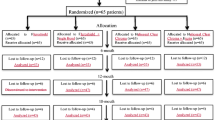Abstract
Aim: To compare the retention of fissure sealants (FS) placed on occlusal surfaces following use of a self etching priming agent and traditional acid etch and to compare the caries incidence of occlusal surfaces sealed using the two techniques over 12 months. Study Design: A randomised controlled trial set in NHS Dental Service and Dental Hospital clinics (UK). Materials and Methods: Subjects (60) were recruited by 7 dental professionals who placed FS on mandibular permanent molar pairs. The technique used for enamel preparation prior to FS placement on the right and left side of the mandible was randomised. On one side of the mandible Xeno® III (Dentsply, Germany) was used to prepare the occlusal enamel and on the other side phosphoric acid etch together with Prime and Bond® (Dentsply, Germany) was used. Opaque Delton® (Dentsply, USA) was used to seal all surfaces. Subjects were blinded to the techniques used. Subjects and operators recorded on individual questionnaires their impressions of the techniques used. Statistics: Results were analysed using the SPSS statistics package. Results: Thirty eight (63%) subjects were seen for review by the principal researcher 12 months after FS placement. The retention was significantly better in the etch group (P=0.003). No statistically significant difference in caries incidence was found between the test and control groups at 12 months. Conclusions: The best practice for placement of sealants remains enamel preparation with acid etch and use of an intermediate bonding layer.
Similar content being viewed by others
References
Ahovuo-Saloranta A, Hiiri A, Nordblad A, Worthington H, Makela M. Pit and fissure sealants for preventing dental decay in the permanent teeth of children and adolescents. Cochrane Database Systematic Review 2004
Atash R, Van den Abbeele A. Bond strengths of eight contemporary adhesives to enamel and to dentine: an in vitro study on bovine primary teeth. Int J Paediatr Dent 2005;15:264–73.
Burbridge L, Nugent Z, Deery C. A randomized controlled trial of the effectiveness of a one-step conditioning agent in sealant placement: 6 month results. Int J Paediatr Dent 2006;16:424–30.
Celiberti P, Lussi A. Use of a self-etching adhesive on previously etched intact enamel and its effect on sealant microleakage and tag formation. J Dent 2005;33 163–71.
Cueto EI, Buonocore MG. Adhesive sealing of pits and fissures for caries prevention. J Dent Res. 1965;44:137.
Deery C, Fyffe HE, Nugent ZJ, Nuttall NM, Pitts NB. A proposed method for assessing the quality of sealants — the CCC Sealant Evaluation System. Community Dent Oral Epidemiol 2001;29:83–91.
Feigal RJ, Hitt J, Splieth C. Retaining sealant on salivary contaminated enamel. J Amer Dent Assoc 1993; 124:88–97.
Feigal RJ, Quelhas I. Clinical trial of a self-etching adhesive for sealant application: Success at 24 months with Prompt-L-Pop. Amer J Dent 2003;16 249–51.
Feigal RJ. Sealant and preventive restorations: review of effectiveness and clinical changes for improvement. Pediatr Dent 1998;20: 85–92.
Gordon PH, Nunn JH. Fissure Sealants. The prevention of oral disease. 2003. Murray JJ, Nunn JH, Steele JG. Oxford University Press.
Gwinnett AJ, Caputo L, Ripa LW, Disney JA. Micromorphology of the fitting surface of failed sealants. Pediatr Dent 1982;4:237–9
Hannig M, Grafe A, Atalay S, Bott B. Microleakage and SEM evaluation of fissure sealants placed by use of self etching priming agents. J Dent 2004; 32:75–81.
Hitt JC, Feigal RJ. Use of bonding agent to reduce sealant sensitivity to moisture contamination: an in vitro study. Pediatr Dent 1992;14:41–6.
Landis JR, Koch GG. The measurement of observer agreement for categorical data. Biometrics 1977; 33: 159–74.
Muller-Bolla M, Lupi-Pégurier L, Tardieu C, Miriam Velly A, Antomarchi C. Retention of resin-based pit and fissure sealants: a systematic review. Community Dent Oral Epidemiol 2006;34:321–36.
Nunn JH, Murray JJ, Smallridge J. British Society of Paediatric Dentistry: a policy document on fissure sealants in paediatric dentistry. Int J Paediatr Dent 2000;10:174–7.
Perdigao J, Fundingsland JW, Duarte S Jr, Lopes M. Microtensile adhesion of sealants to intact enamel. Int J Paediatr Dent 2005;15:342–8.
Perdigao J, Geraldeli S. Bonding characteristics of self etching adhesives to intact versus prepared enamel. J Esthet Rest Dent 2003; 15: 32–41.
Pitts NB, Fyffe HE. The effect of varying diagnostic thresholds upon clinical caries data for a low prevalence group. J Dent Res 1988; 67:592–6.
SIGN. Preventing dental caries in children at high caries risk. Targeted prevention of dental caries in the permanent teeth of 6–16 year olds presenting for dental care. SIGN Publication No. 47 2000.
Takeuchi M. On caries controlling methods (in Japenese). Shikwa Gakuho 1964; 63: 179–84.
Thomson JL, Main C, Gillespie FC, Stephen KW. The effect of salivary contamination on fissure sealant — enamel bond strength. J Oral Rehab 1981;8 11–18.
Van Meerbeek B, De Munck J, Yoshida Y, et al. Buonocore memorial lecture. Adhesion to enamel and dentin: current status and future challenges. Operat Dent 2003;28:215–35.
Venker DJ, Kuthy RA, Qian F, Kanellis MJ. Twelve-month sealant retention in a school-based program using a self-etching primer/adhesive. J Pub Health Dent 2004;4:191–7.
Author information
Authors and Affiliations
Corresponding author
Rights and permissions
About this article
Cite this article
Burbridge, L., Nugent, Z. & Deery, C. A randomized controlled trial of the effectiveness of a one-step conditioning agent in fissure sealant placement: 12 month results. Eur Arch Paediatr Dent 8, 49–54 (2007). https://doi.org/10.1007/BF03262570
Published:
Issue Date:
DOI: https://doi.org/10.1007/BF03262570




